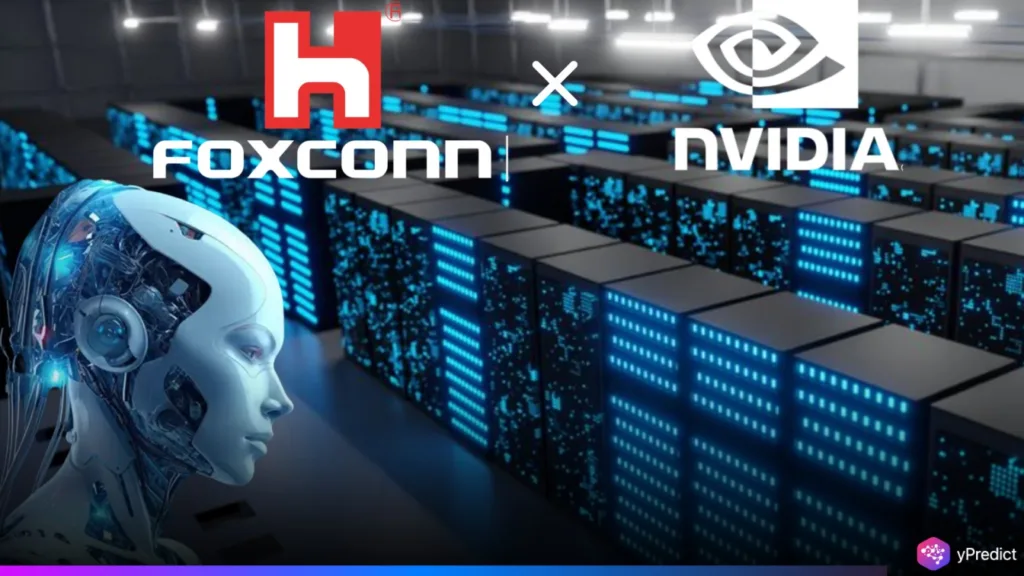
Foxconn announced a strategic partnership with Nvidia to build a 100-megawatt AI data center in Taiwan, boosting global AI infrastructure. The center will support next-generation AI applications in smart cities, electric vehicles, and advanced manufacturing through phased construction. Combining Nvidia’s powerful AI chips with Foxconn’s industrial expertise, the project highlights Taiwan’s growing role in the global AI ecosystem. This partnership marks a foundational step in building the Foxconn-NVIDIA AI infrastructure that will power Taiwan’s AI transformation.
Foxconn Nvidia AI Infrastructure for the Future
According to Nvidia’s official press release, Foxconn plans to collaborate with Nvidia and Taiwan’s government on large-scale AI infrastructure. Announced at the Computex trade expo in Taipei, the project supports Taiwan’s ambition to become a global AI innovation hub. Nvidia founder and CEO Jensen Huang described the AI revolution as a powerful engine driving the next wave of industrial growth.
AI has ignited a new industrial revolution — science and industry will be transformed. We are delighted to partner with Foxconn and Taiwan to help build Taiwan’s AI infrastructure, and to support TSMC and other leading companies to advance innovation in the age of AI and robotics.
As part of the partnership, Foxconn and Nvidia will build an advanced AI supercomputing facility, termed an “AI factory,” in phases. The facility will initially offer 100 megawatts of capacity and feature up to 10,000 Nvidia Blackwell Ultra GPUs. These GPUs will connect using NVLink, Quantum InfiniBand, and Spectrum-X Ethernet to ensure high-speed data transfer and performance efficiency.
Foxconn, through its subsidiary Big Innovation Company, will build and operate Taiwan’s AI infrastructure using Nvidia’s GB300 NVL72 systems. As an official Nvidia Cloud Partner, the company will support early adopters like TSMC, which will use the platform for advanced R&D. Taiwan’s National Center for High-Performance Computing will upgrade its system with 1,700 HGX H200 GPUs and Blackwell-based HGX B300 units. The upgrade, including GB200 NVL72 systems, promises up to eight times the performance of the center’s previous supercomputing architecture.
The AI facility will begin construction in Kaohsiung, with additional sites planned based on regional power availability and infrastructure needs. This infrastructure will support a wide range of applications, including industrial research, government services, academic initiatives, and commercial ventures. Speaking at Computex, Foxconn Chairman and CEO Young Liu emphasized the strategic vision driving the partnership with Nvidia. He said,
Foxconn builds technology that underpins modern life, and now, we’re building computing infrastructure to scale the next generation of breakthroughs across Taiwan. By building this AI factory with Nvidia and TSMC, we are laying the groundwork to connect people in Taiwan as well as government organizations and enterprises such as TSMC to accelerate innovation and empower industries.
Deepening AI Cooperation and Global Implications
This development builds on the 2023 alliance, when Foxconn and Nvidia unveiled plans to create centralized AI factory hubs. These facilities aim to train and deploy AI models while remaining modular, energy-efficient, and scalable for future technological demands. The joint vision reflects a long-term commitment to building robust, adaptive infrastructure for next-generation artificial intelligence applications.
Taiwan’s government, through the National Science and Technology Council, sees the AI supercomputer project as central to its plan for an AI-driven industrial ecosystem in the island’s south. Minister Wu Cheng-Wen emphasized efforts to integrate AI across sectors, aiming to build a “smart island” powered by intelligent infrastructure.
Conclusion
This AI endeavour in Taiwan contributes to Nvidia’s overall global strategy. Just weeks ago, the business announced plans to invest up to $500 billion over four years to create AI supercomputers around the United States. However, the Taiwan project stands out for its collaborative strategy, which brings together the government, universities, and prominent tech corporations to form a national AI backbone.
While the exact timeframe for deployment has yet to be revealed, the infrastructure is likely to go live in stages beginning later this year.






